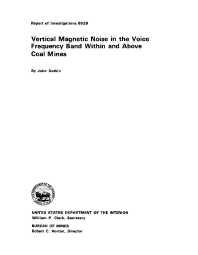Mining Publication: Vertical Magnetic Noise in the Voice Frequency Band Within and Above Coal Mines
Original creation date: December 1983
Information on vertical magnetic noise in the voice frequency band, both within and above coal mines, is needed for the evaluation of through-the-earth baseband electromagnetic communications at mines where horizontal loop antennas are used. This report discusses the theory of the source of electromagnetic noise, the propagation of this noise to an observation point above a mine, and its interaction with the local earth conductivity structure, which gives rise to vertical magnetic noise. The relationship of surface noise to underground noise is also discussed. Bureau of Mines investigators made surface and underground vertical magnetic noise measurements at a number of coal mines located throughout the United States. These data were modeled through regression analysis to characterize expected noise levels. The results are presented, including results in one-third octaves for use in evaluating the expected performance of through-the-earth communication systems by articulation-index studies.
Authors: JA Durkin
Report of Investigations - December 1983
NIOSHTIC2 Number: 10003224
Pittsburgh, PA: U.S. Department of the Interior, Bureau of Mines, RI 8828, 1983 Dec; :1-27
See Also
- Determination of Sound Exposures (DOSES): Software Manual and Implementation Guide
- DOSES - Determination of Sound Exposures - 1.1
- Electromagnetic Noise Data Acquisition for the Evaluation of TTE Communications in Coal Mines
- Technology News 536 - NIOSH Develops New Software to Analyze and Reduce Noise Exposure
- Theoretical Noise and Propagation Models for Through-the-earth Communication
- Through-the-Earth (TTE) Communications: Range Reliability Improvements
- Through-The-Earth Wireless Real-Time Two-Way Voice Communications
- Two-Way, Through-the-Earth Emergency Communication System for Trapped Miners and the Surface
- Ultra-Low Frequency Through-the-Earth Communication Technology
- What Does a Hearing Loss Sound Like?
- Content source: National Institute for Occupational Safety and Health, Mining Program


 ShareCompartir
ShareCompartir
